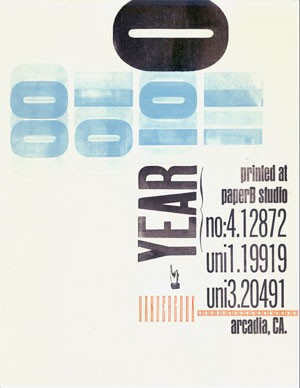 Check out the gallery of 90 or so prints celebrating the first one hundred years of Vandercook proof presses. This was a limited edition exchange of letterpress prints, organized by Paul Moxon.
Check out the gallery of 90 or so prints celebrating the first one hundred years of Vandercook proof presses. This was a limited edition exchange of letterpress prints, organized by Paul Moxon.
 Check out the gallery of 90 or so prints celebrating the first one hundred years of Vandercook proof presses. This was a limited edition exchange of letterpress prints, organized by Paul Moxon.
Check out the gallery of 90 or so prints celebrating the first one hundred years of Vandercook proof presses. This was a limited edition exchange of letterpress prints, organized by Paul Moxon.
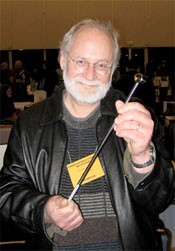 If you could ask someone just 3 questions, what would they be? That’s the premise behind the website Qu3stions (actually, they say their site is “an opportunity to listen in on short but illuminating conversations with interesting people”.) Their first interview was with Southern California letterpress printer Gerald Lange (that’s Gerald to the left). Gerald printed one of my favorite broadsides — Rabbits do not know what they are — and is a moderator on the PPLetterpress yahoo group. See the questions and answers here.
If you could ask someone just 3 questions, what would they be? That’s the premise behind the website Qu3stions (actually, they say their site is “an opportunity to listen in on short but illuminating conversations with interesting people”.) Their first interview was with Southern California letterpress printer Gerald Lange (that’s Gerald to the left). Gerald printed one of my favorite broadsides — Rabbits do not know what they are — and is a moderator on the PPLetterpress yahoo group. See the questions and answers here.
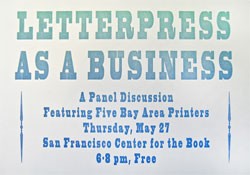 Recently the San Francisco Center for the Book hosted a panel discussion with five Bay area letterpress printers discussing what it means to run a letterpress business. The panelists were Joel Benson of Dependable Letterpress, Norman Clayton of Classic Letterpress, Susie Gelbron of Carrot & Stick Press, Patrick Reagh of Patrick Reagh Printers Inc., and John Sullivan of Logos Graphics. There’s a four part audio series of the discussion (the 4 segments are Introductions, Job Costs and Pricing, Q&A, Finishing and More Q&A). Over on Felt and Wire, you can read a recap of the event.
Recently the San Francisco Center for the Book hosted a panel discussion with five Bay area letterpress printers discussing what it means to run a letterpress business. The panelists were Joel Benson of Dependable Letterpress, Norman Clayton of Classic Letterpress, Susie Gelbron of Carrot & Stick Press, Patrick Reagh of Patrick Reagh Printers Inc., and John Sullivan of Logos Graphics. There’s a four part audio series of the discussion (the 4 segments are Introductions, Job Costs and Pricing, Q&A, Finishing and More Q&A). Over on Felt and Wire, you can read a recap of the event.
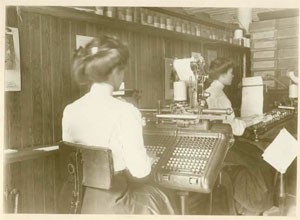 Last weekend I stumbled upon an online exhibit from Princeton University Library’s Graphic Arts Collection called Unseen Hands: Women Printers, Binders and Book Designers. The introduction to the exhibit starts
Last weekend I stumbled upon an online exhibit from Princeton University Library’s Graphic Arts Collection called Unseen Hands: Women Printers, Binders and Book Designers. The introduction to the exhibit starts
Women have been involved in printing and the making of books ever since these crafts were first developed. Even before the advent of movable type, there was a strong tradition of women producing manuscripts in western European religious houses. In the Convent of San Jacopo di Ripoli in Florence, we find the first documented evidence, in 1476, of women working as printers. Girls and women were often trained by their fathers or husbands to assist in printing businesses, and there are many instances from the fifteenth to the eighteenth centuries of women taking over and managing these enterprises upon the early demise of their male relatives.
It’s nicely arranged — you can look at the women featured by name, occupation, thumbnails of their work or on a timeline. Links lead you to a short summary of each woman’s work and more pictures.
![]() Pictured above, women setting type at a monotype machine at the Riverside Press, Cambridge, 1911 (seen here).
Pictured above, women setting type at a monotype machine at the Riverside Press, Cambridge, 1911 (seen here).
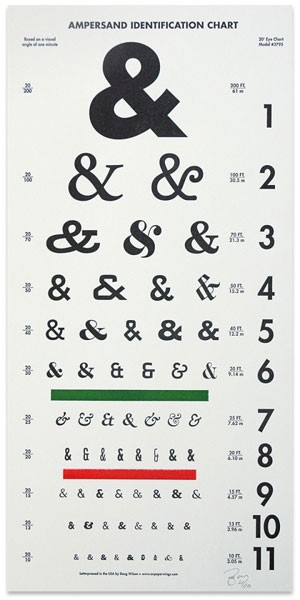 Doug Wilson makes letterpress posters from his collection of wood type. This one is an “Ampersand ID Chart” based on the familiar Snellen eye chart. And here’s another one:
Doug Wilson makes letterpress posters from his collection of wood type. This one is an “Ampersand ID Chart” based on the familiar Snellen eye chart. And here’s another one:
{First seen here}
 Long ago, my friend Kate suggested that I print fabric patches using my collection of wood type. I think about this from time to time and even bought iron-on patches to experiment on. But somehow nothing ever came of the idea. A printing collective in England, SORT (for “Society Of Revisionist Typographers”) has something even better — several sew-on patches, printed letterpress, with Victorian slang names for types of common rogues: smatter hauler (hanky thief), drag sneak (luggage thief) and tooler (pickpocket). See them all here.
Long ago, my friend Kate suggested that I print fabric patches using my collection of wood type. I think about this from time to time and even bought iron-on patches to experiment on. But somehow nothing ever came of the idea. A printing collective in England, SORT (for “Society Of Revisionist Typographers”) has something even better — several sew-on patches, printed letterpress, with Victorian slang names for types of common rogues: smatter hauler (hanky thief), drag sneak (luggage thief) and tooler (pickpocket). See them all here.